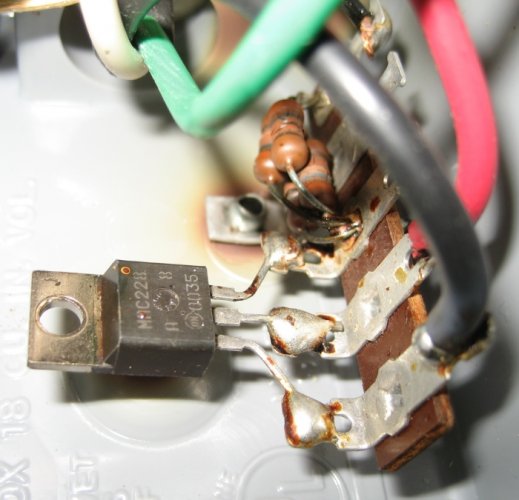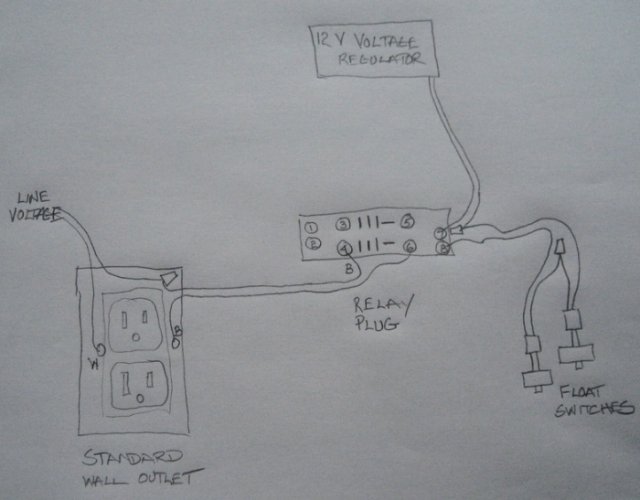Interesting that you mention the Tunze, i was about to order it, but i guess since you had better results with your diy then i guess im going to go that route first and see what happend, also i notice you have a 12v resistor on the diagram, any particular one i should get or any 12v resistor will do? Sorry for so many questions but i rather get input from guys that knows what is doing with different set up and time reefing, thanks once againI've built one myself and used it on my previous setup for almost 2 years and it never failed, I'm currently using the Tunze on my new setup and it has failed like 4 times in less than 2 months due to the optical sensor getting dirty.
I've been thinking about switching the Tunze for my DIY one since I still have it.
When making your own try getting a good quality float switch to make it more reliable.
-
Folks, if you've recently upgraded or renewed your annual club membership but it's still not active, please reach out to the BOD or a moderator. The PayPal system has a slight bug which it doesn't allow it to activate the account on it's own.
You are using an out of date browser. It may not display this or other websites correctly.
You should upgrade or use an alternative browser.
You should upgrade or use an alternative browser.
DIY Float Switch on the Cheap
- Thread starter redfishbluefish
- Start date
Salted
NJRC Member
If the siphon from the overflow breaks, you're no longer draining water from the dt to the sump. The return would then only pump whatever water is in the return chamber back to the display and go empty. DT water level should be adjusted to handle this.I got you, im asking becuase i want set up a float switch to shut off my return pump if the siphon from my over flow break, i have a 12v dc relay, the float switch, but never found a way to hook it up since no one talk about hooking up the 12v (dc) relay to 120 volts. Thanks for the input, very cool your project by the way
Yeah, any 12v would work.Interesting that you mention the Tunze, i was about to order it, but i guess since you had better results with your diy then i guess im going to go that route first and see what happend, also i notice you have a 12v resistor on the diagram, any particular one i should get or any 12v resistor will do? Sorry for so many questions but i rather get input from guys that knows what is doing with different set up and time reefing, thanks once again
Interesting that you mention the Tunze, i was about to order it, but i guess since you had better results with your diy then i guess im going to go that route first and see what happend, also i notice you have a 12v resistor on the diagram, any particular one i should get or any 12v resistor will do? Sorry for so many questions but i rather get input from guys that knows what is doing with different set up and time reefing, thanks once again
There is no added resistor in my DIY. You might be referring to this picture of the OLD voltage supply:

that contains a Triac and resistors. I don't want to get into the details of this, because, as you can see, the resistors are toasty brown....so not recommended. The resistors lower the voltage at the gate of the triac as well as limit the gate current....but you're still close to 120 volts at the float switches.....SO DON'T DO THIS ONE.
Again, here is the diagram of what I built, and what I recommend:

You have a 12V power supply, the relay switch, float switches, and an outlet/box for the pump you wish to run.....and some wire. That's it, no resistor.
EDIT TO ADD:
and ask away with questions....I'll answer any and all questions, and with pictures, if that helps.
Last edited:
I agree with you but i also need to prevent the sump pump from running dry and burn upIf the siphon from the overflow breaks, you're no longer draining water from the dt to the sump. The return would then only pump whatever water is in the return chamber back to the display and go empty. DT water level should be adjusted to handle this.
Interesting that you mention the Tunze, i was about to order it, but i guess since you had better results with your diy then i guess im going to go that route first and see what happend, also i notice you have a 12v resistor on the diagram, any particular one i should get or any 12v resistor will do? Sorry for so many questions but i rather get input from guys that knows what is doing with different set up and time reefing, thanks once again
After re-reading your question I realized you might be talking about either the 12V power supply OR the relay switch, and NOT A RESISTOR....so need to talk amps.
POWER SUPPLY: I can't see what amp rating I purchased for the 12v power supply, but it's only running the relay and float switches....and guess it's 0.5 to 1 amp....way more than what's needed.
RELAY SWITCH: You want a relay that is equal to or more amps than what it's running (In this case, a pump). In my case, it's a 5 amp relay....way more than what's needed. No problem getting a relay with MORE amps than what it's running.
Hope this helps.
Salted
NJRC Member
I don't have much time in the hobby so it would be nice to hear from more experienced members but, jebao pumps claim they shut off if they run dry. Amazon.com. Not sure how but that's their claim. Sicce claims that their pumps have "thermal protection to prevent overheating" Syncra SILENT - MULTIFUNCTION PUMPS - Products but I read everything I could find on their site and they don't explain what that is specifically. Just something to consider and research if your diy project doesn't turn out like you want. GL and welcome to the siteI agree with you but i also need to prevent the sump pump from running dry and burn up
Paul you are right about the "12v power supply " instead of resistor.After re-reading your question I realized you might be talking about either the 12V power supply OR the relay switch, and NOT A RESISTOR....so need to talk amps.
POWER SUPPLY: I can't see what amp rating I purchased for the 12v power supply, but it's only running the relay and float switches....and guess it's 0.5 to 1 amp....way more than what's needed.
RELAY SWITCH: You want a relay that is equal to or more amps than what it's running (In this case, a pump). In my case, it's a 5 amp relay....way more than what's needed. No problem getting a relay with MORE amps than what it's running.
Hope this helps.
My diy ato I went straight 120v and no 12v power supply.

